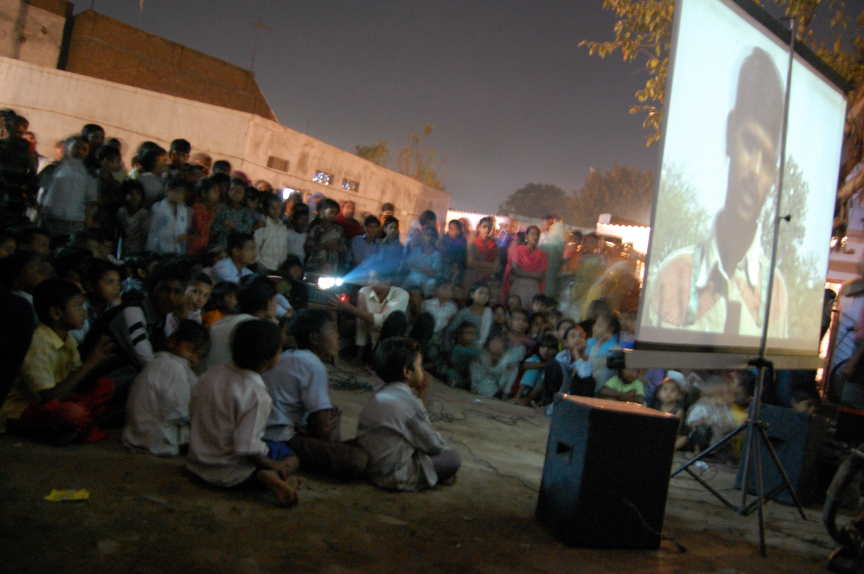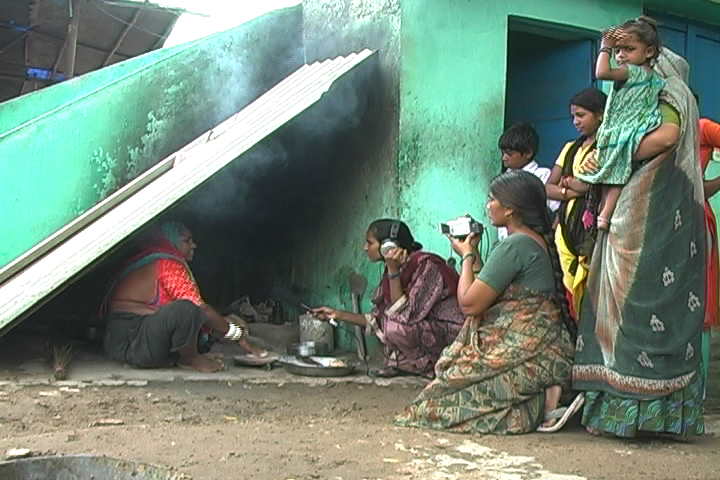Community Video Units
 From 2006-2010, Video Volunteers established 13 Community Video Units (CVUs) with 13 different Indian NGOs. The purpose of CVUs was to foster community ownership of the media production process, to build platforms for communities to dialog and find solutions, and to empower people to take action on local issues.
From 2006-2010, Video Volunteers established 13 Community Video Units (CVUs) with 13 different Indian NGOs. The purpose of CVUs was to foster community ownership of the media production process, to build platforms for communities to dialog and find solutions, and to empower people to take action on local issues.
The topics of the films were decided by community editorial boards. The films were then screened back on widescreen projectors to thousands of people in the community.
The Production Model
- CVUs were local production entities run by up to 10 community members, called Community Video Producers, who were chosen by the host NGOs.
- The Community Video Producers did not need to be literate or have any previous exposure to technology.
- The 6-10 Community Producers worked full-time and receive a salary.
- Each CVU had digital video cameras, computers for editing, a TV, and a wide screen projector and sound system for outdoor screenings.
- Producers were trained full-time, on-site for 12-18 months by a professional filmmaker.
- The CVUs created a local Editorial Board of community members from approximately 25 villages who proposed topics for the programs and helped to arrange screenings.
- The CVU produced one 30-minute video magazine every eight weeks on different social issues.
- The video magazine was screened every eight weeks month in 25 villages or Bastis (slums) and ended with calls for action. With an average of 200 people at each screening, the video reached around 5000 people in community settings alone.
The Content
 Each CVU produced a “Video News Magazine” every six weeks. The content of the Video Magazine was based on viewer feedback and key campaign issues decided by a Community Editorial Board, the CVU Producers and the sponsor NGO. Different segments includde:
Each CVU produced a “Video News Magazine” every six weeks. The content of the Video Magazine was based on viewer feedback and key campaign issues decided by a Community Editorial Board, the CVU Producers and the sponsor NGO. Different segments includde:
- Community News – the issues of poor communities, such as
government schemes, local health issues and upcoming events that are not covered by the mainstream news - Opinion Polls – that capture community consensus and call to action on particular issues
- Success Stories – such as families that have found economic success through educating their girls
- Short Documentaries – for example, stories where families speak out against alcoholism
- Legal Tips – i.e., what to do if your name is not on a voter’s list
- Local Culture and Music – could be introductions to the festivals of another community/religion
- Video raids – such as short clips of closed government health services followed by an on-the-fly interview with the concerned government officials
- Editorial – where the organization and the reporters give their analysis on the problem and why it exists and what should be done
- Local humor/jokes/skits – because we need to make people laugh!
- Calls to Action – each film ends with a concrete call to action, decided as part of a local advocacy campaign – that the community can undertake. The ‘call to action’ is the focus of the post-screening discussion.
The impact of the VV CVUs
- More than 200 half hour video news magazines were produced.
- 150 community members learned to be filmmakers
- More than 3000 wide-screen projector screenings were conducted in over 300 villages, reaching approximately 250,000 people.
- The CVUs led to thousands of people taking action.
- The CVUs also built the communications capacities of the local NGOs, who learned how to use digital media to rally the community, listen to the community’s needs, foster community ownership of their programs and to advocate better on their issues at a national level.
- Dozens of students, filmmakers and other NGOs studied our model and incorporated aspects of this model – which was one of the most intensive explorations of hyper-local media ever undertaken – into projects all over the world, from China to Kenya.
However, the Community Video Unit model was fairly expensive, especially given the cost of cameras and computers at that time. Video Volunteers had envisioned that communities would be able to financially sustain the CVUs through things like micro-payments at community screenings, making wedding videos and NGO productions, and running ads in the videos for local or national businesses. We worked with the leading business school of India, IIM-Ahmedabad, on a two year research project into the financial modeling of hyperlocal media units. However we found that in the very marginalized communities where we worked, this was unrealistic within our short time frame. So, by 2011, most of the CVUs had run out of funds. In several cases they were turned into NGO media units; in other cases the Producers took on jobs as freelance filmmakers, workers in Bollywood or in NGOs.
In response, VV searched for a lower cost model of community video production, and thus the IndiaUnheard Network was created. Several Community Producers began to work directly with Video Volunteers as IndiaUnheard Community Correspondents.
VV is now developing a new model of hyperlocal community-owned media, adapted to the new technological environment in which smartphones and internet are making their way into the most marginalized communities.
Learn about starting your own CVU here.

